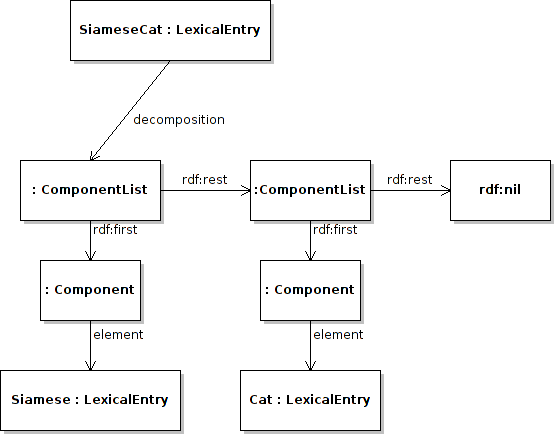Next: Phrase structures Up: Phrase Structure Module Previous: Phrase Structure Module Contents
The base method for representing multi-word lexical entries is by decomposing them into their component words, this is done through the usage of RDF lists of component objects. This works as follows.
:siamese_cat lemon:decomposition ( [ lemon:element :siamese ] [ lemon:element :cat ] ) .
Note that the above example uses the RDF list mechanism, which, while relatively compact in Turtle syntax, can get quite large in N-Triples form, e.g.,
:siamese_cat lemon:decomposition :siamese_cat_LoC . :siamese_cat_LoC rdf:first :siamese_cat_C1 . :siamese_cat_LoC rdf:rest :cat_LoC . :siamese_cat_C1 lemon:element :siamese . :cat_LoC rdf:first :siamese_cat_C2 . :cat_LoC rdf:rest rdf:nil . :siamese_cat_C2 lemon:element :cat .

Compound words may also be broken up by the use of components for example, the German word “Schweineschnitzel” is composed of “Schwein” and “Schnitzel”.8
:schweineschnitzel lemon:decomposition ( [ lemon:element :schwein ] [ lemon:element :schnitzel ] ) .
lemon indicates the difference between compound words and phrases by the use of the classes Word and Phrase. As such it is possible to indicate that the composition is a separation of a multi-word expression into words, by adding type statements for the elements.
:siamese_cat a lemon:Phrase ;
lemon:decomposition (
[ lemon:element :siamese ]
[ lemon:element :cat ] ) .
:siamese a lemon:Word .
:cat a lemon:Word .
A third subclass of lexical entry, Part, is provided for “part of words”, e.g., affices, which cannot be realised by themselves but may be stored in the lexicon. For example:
:preordain lemon:decomposition ( [ lemon:element :pre ] [ lemon:element :ordain ] ) . :pre a lemon:Part . :ordain a lemon:Word .
We must note here the decomposition property is not intended for modelling phrase structure, lemon contains a separate mechanism for modelling this described in sections 2 and 4.
John McCrae 2012-07-31